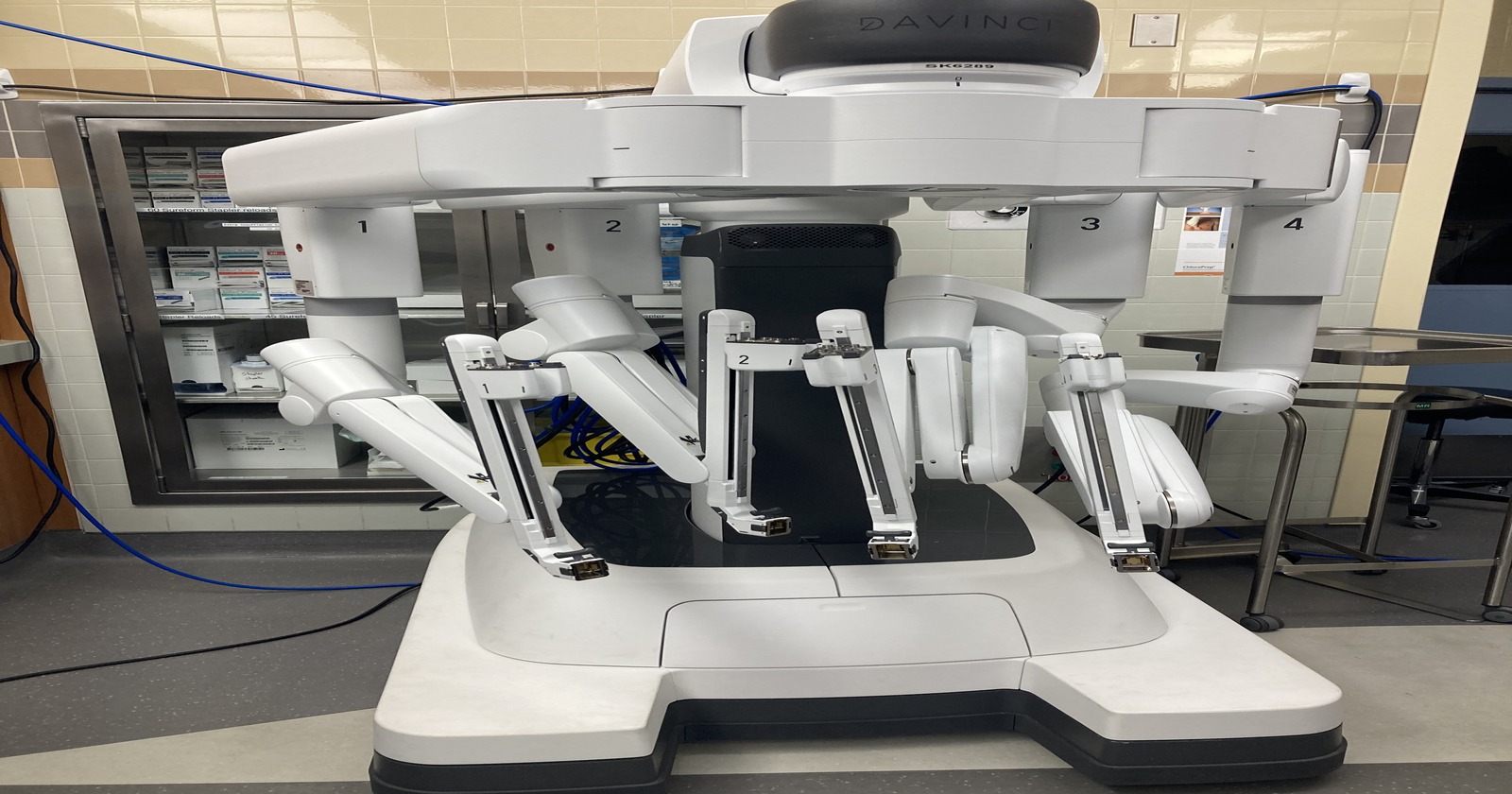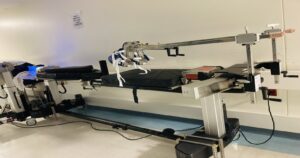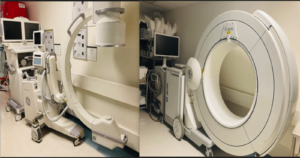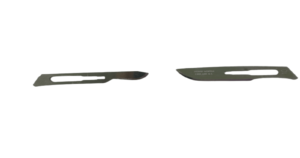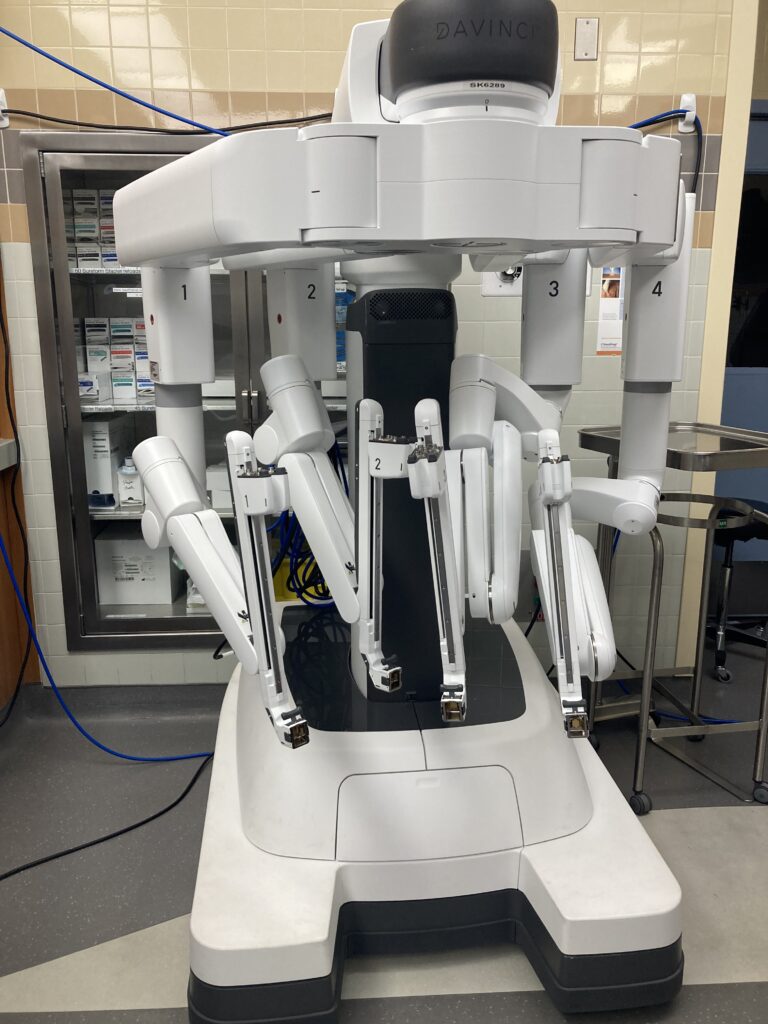
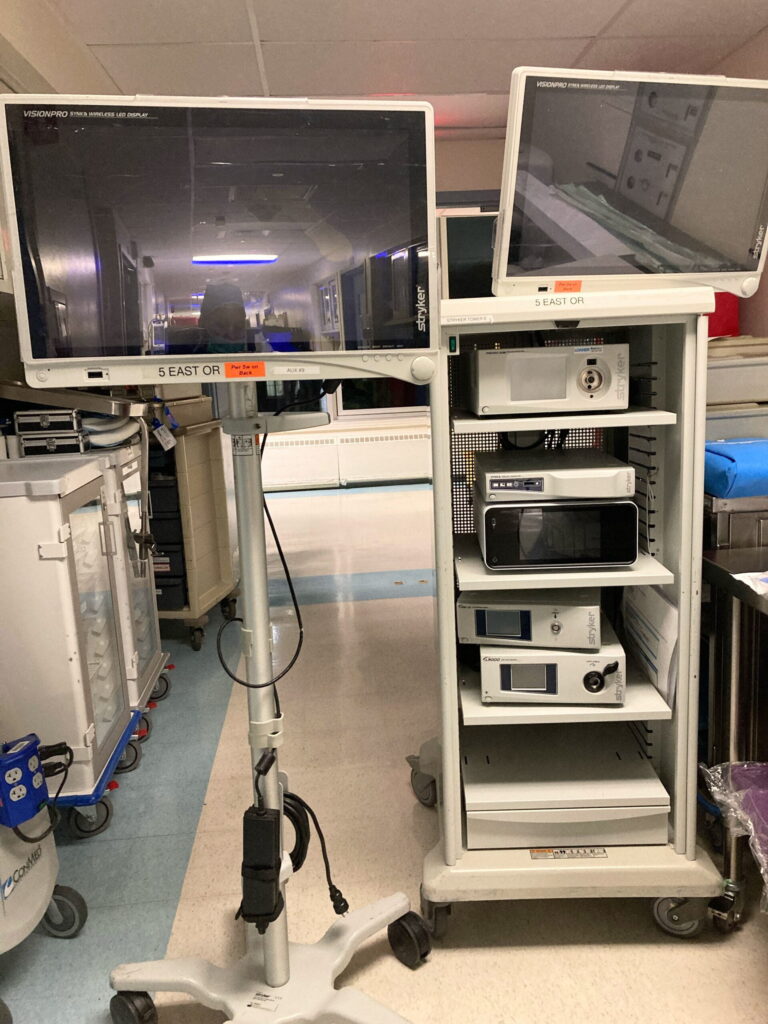
Robotic-assisted surgery, the surgeon controls robotic arms equipped with surgical instruments from a console.
The system translates the surgeon’s hand movements into precise movements of the instruments inside the patient’s body.
laparoscopic surgery, small incisions are made in the abdomen through which a camera (laparoscope) and surgical instruments are inserted. The surgeon performs the surgery by manipulating the instruments externally.
While they share the common goal of reducing patient trauma and promoting quicker recovery times, they differ significantly in terms of technology, precision, and the surgeon’s level of control.
In the rapidly advancing landscape of surgical technology, robotic-assisted procedures, and traditional laparoscopy stand as pillars of minimally invasive surgery.
This exploration aims to shed light on the intricacies of robotic surgery and laparoscopy, offering insights into their unique strengths and areas of specializations.
Differences between Robotic surgery and laparoscopic
| Robotic Surgery | Laparoscopic Surgery |
|---|---|
| Surgeon controls robotic arms remotely | Surgeon directly operates instruments via ports |
| High precision and dexterity with robotic arms | Limited range of motion with handheld tools |
| 3D, high-definition imaging provided | 2D imaging with limited depth perception |
| Seated at console, away from patient | Stands at patient’s side |
| Filters out hand tremors for precise movements | Surgeon’s hand movements directly affect tools |
| Enhanced range of motion and articulation | Limited by the range of human hand movements |
| Longer learning curve due to technology mastery | Shorter learning curve, but still requires training |
| Higher initial cost for equipment and maintenance | Lower initial cost, but ongoing equipment upkeep |
| Small incisions due to robotic precision | Small incisions, but may require more ports |
| Faster recovery due to minimally invasive nature | Generally faster recovery compared to open surgery, but longer than robotic surgery |
| Increased access to difficult-to-reach areas | Limited access, may require repositioning ports |
| Reduced fatigue due to ergonomic setup | Potential for fatigue due to prolonged standing |
| Limited availability for immediate use in emergencies | Immediate availability for emergency procedures |
| Limited availability in some healthcare facilities | Widely available in many healthcare settings |

Robotic assisted Surgery
- Robotic surgery often involves higher initial costs due to the expensive equipment and infrastructure required.
- Specialized training is imperative for the surgical team involved
- Specialized equipment is essential for robotic surgery
- The time required for a robotic procedure is often greater than that of laparoscopic surgery.
- Need lots of space to operate effectively.
- Surgeon control of the procedure is somewhat reduced due to lack of immediate presence at the sterile field .
- The extensive array of equipment necessitates frequent maintenance which is much more costly than laparoscopic surgery equipment.
- recovery time is slightly longer than laparoscopic surgery time or it can be the same in some cases.
- Transitioning from robotic-assisted surgery to traditional open surgery in an emergency situation is often marked by reduced precision and a less efficient process.
Laparoscopic surgery
- laparoscopic surgery is considered more cost-effective than robotic surgery
Cost 2022-2023 Based on the latest information:
https://health.costhelper.com/
- Laparoscopic Hernia Surgery: $6,000 – $10,000
- Robotic Hernia Surgery: $7,000 – $12,000

https://health.costhelper.com/

Laparoscopic Hernia Surgery: Average cost around $8,000
Robotic Hernia Surgery: Average cost around $9,500
Requires less specialized training compared to robotic surgery.
Characterized by its relatively low requirement for specialized equipment.
Require less time for procedure.
Laparoscopic surgery typically requires less physical space in the operating room compared to robotic surgery.
In laparoscopic procedures, the surgeon maintains direct control over the surgical process by being physically present in the sterile surgical field.
The cost of maintaining equipment tends to be lower compared to robotic systems. Equipment is generally more durable and less technologically intricate, which reduces the need for frequent repairs or upgrades.
Patients who undergo laparoscopic surgery tend to have shorter hospital stays and quicker recovery times.
Converting to an open surgery in an emergency situation is done quickly and smoothly.
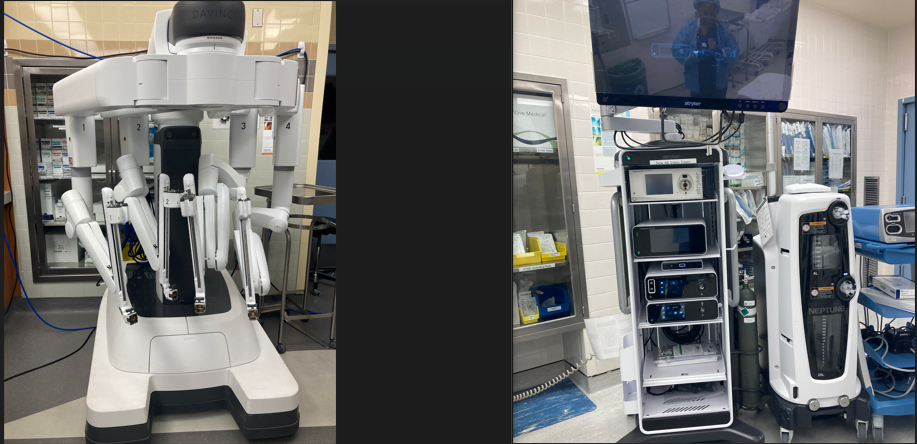
10 Advantages and Disadvantages of Robotic assisted Surgery
1. Precision: Robotic surgery offers enhanced precision, allowing for delicate and complex procedures with minimal damage to surrounding tissues.
2. Minimally Invasive: Robotic systems enable surgeons to perform minimally invasive procedures, resulting in smaller incisions, less pain, and faster recovery times for patients.
3. 3D Visualization: Surgeons benefit from high-definition, 3D visualization of the surgical site, providing improved clarity and depth perception compared to traditional methods.
4. Reduced Tremors: Robotic systems filter out hand tremors, ensuring steadier movements during surgery, which is particularly beneficial for delicate procedures.
5. Ergonomics: Surgeons operate from a console, offering ergonomic advantages by reducing physical strain during lengthy procedures, leading to less fatigue and greater precision.
6. Access to Tight Spaces: Robotic arms can access confined or hard-to-reach areas within the body more easily than human hands, enabling surgeons to perform surgeries in challenging anatomical locations.
7. Faster Recovery: Patients often experience shorter hospital stays and quicker recovery times due to the minimally invasive nature of robotic surgery, leading to a faster return to normal activities.
8. Reduced Complications: With enhanced precision and control, robotic surgery can reduce the risk of complications such as bleeding and infection, improving overall surgical outcomes.
9. Telemedicine Potential: Robotic surgery systems can be operated remotely, opening up possibilities for telemedicine and allowing expert surgeons to perform procedures from afar, potentially increasing access to specialized care in remote areas.
10. Training and Skill Development: Robotic surgery platforms offer simulation-based training modules, allowing surgeons to develop and refine their skills in a controlled environment before performing procedures on patients, ultimately improving surgical outcomes

Disadvantages of Robotic Surgery
Robotic Surgery has a higher initial costs for hospitals due to expensive equipment and infrastructure. Patients experience higher costs due to maintenance and usage expenses of robotic systems during surgery.
Robotic procedures may take longer due to setup time, docking and undocking of the robot, and the learning curve associated with its use.
Disposable instruments used in robotic surgery are more expensive than those used in laparoscopy.
Specialized training is crucial for the surgical team to operate and manage robotic systems effectively, reducing the risk of patient injury.
Some hospitals allocate time for doctors and staff to practice procedures and control of the robot before performing on patients.
Physician assistants specializing in robotic surgery are present during procedures to assist with technical aspects such as instrument attachment and guidance for junior surgeons.
Hospitals provide training for staff to set up, troubleshoot, and maintain robotic instruments.
A patient service leader, often an operating room registered nurse, oversees robotic setups and is available during procedures for assistance.
Specialized beds are essential for robotic surgery, designed to collaborate with the Da Vinci Robot, preventing movement during procedures to avoid patient harm.

Robotic surgery may require more time compared to laparoscopic surgery due to reduced direct control by the surgeon.
Surgeons typically operate from a console during robotic procedures, which can increase the procedural duration.
When severe bleeding occurs, surgeons must interrupt the robotic operation to don sterile attire before manually addressing the bleeding.
This interruption, though necessary for patient safety, can prolong the overall procedure time.
Robotic surgery requires a significant amount of space to operate effectively. This need for a larger operating area is distinct from laparoscopic
procedures. The requirement for space arises from the extensive equipment and accessories needed for robotic surgery.
Converting from robotic-assisted surgery to traditional open surgery in an emergency lacks precision and is less streamlined.
Disparities in instruments and surgical arrangements contribute to the challenge of transitioning.
Disengaging the robotic system and extracting its arms in an emergency is not swift or seamless.
Electrical and software malfunctions during robotic surgery can have devastating consequences.
How The Robotic System and its parts works
Surgical System, which consists of a console for the surgeon to control the robot’s movements, a patient-side cart with robotic arms, and a high-definition vision system.

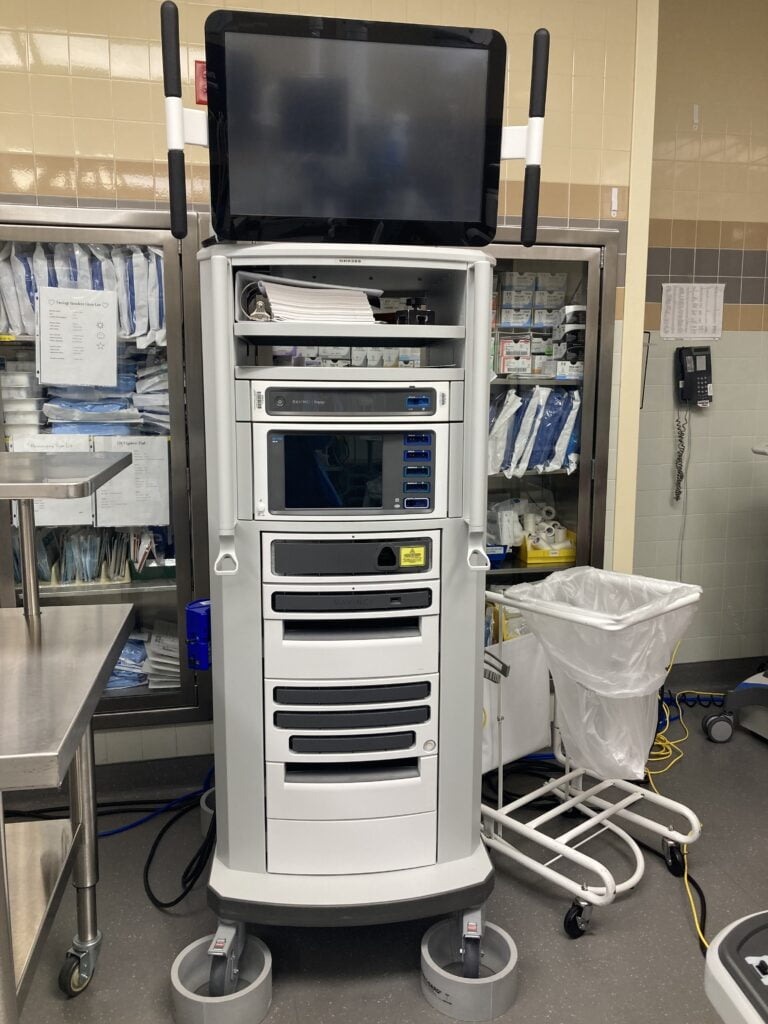
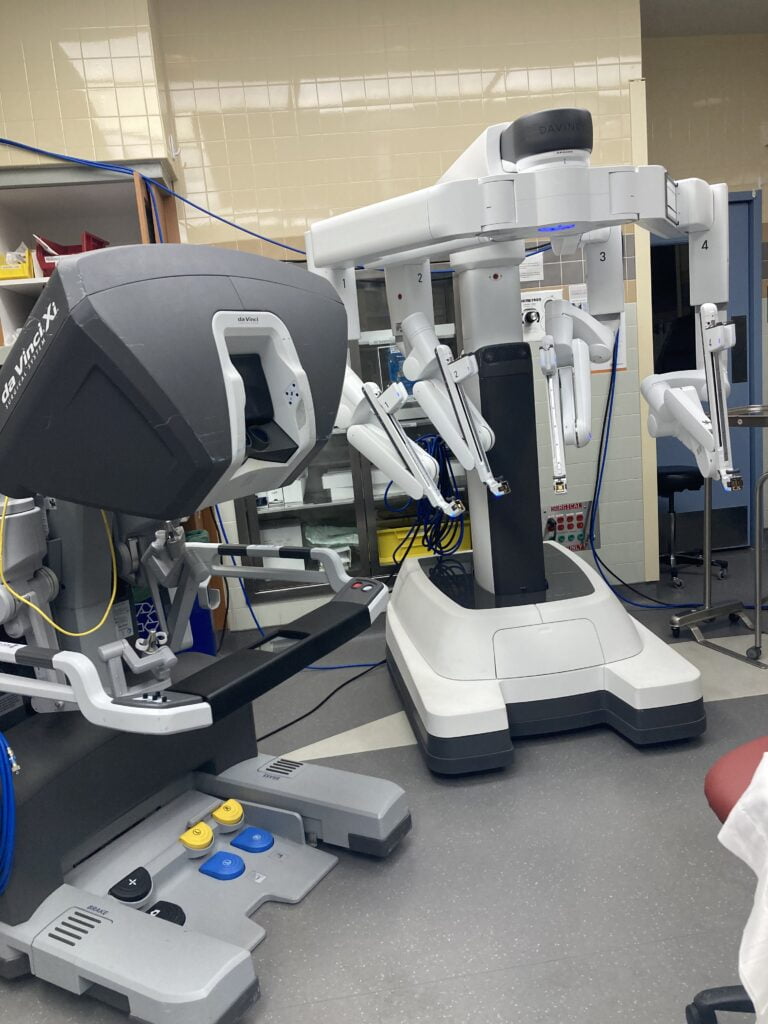
Surgical Instruments: These are specialized tools designed to work with the robotic system. They include forceps, scissors, graspers, and other instruments used in various surgical procedures.

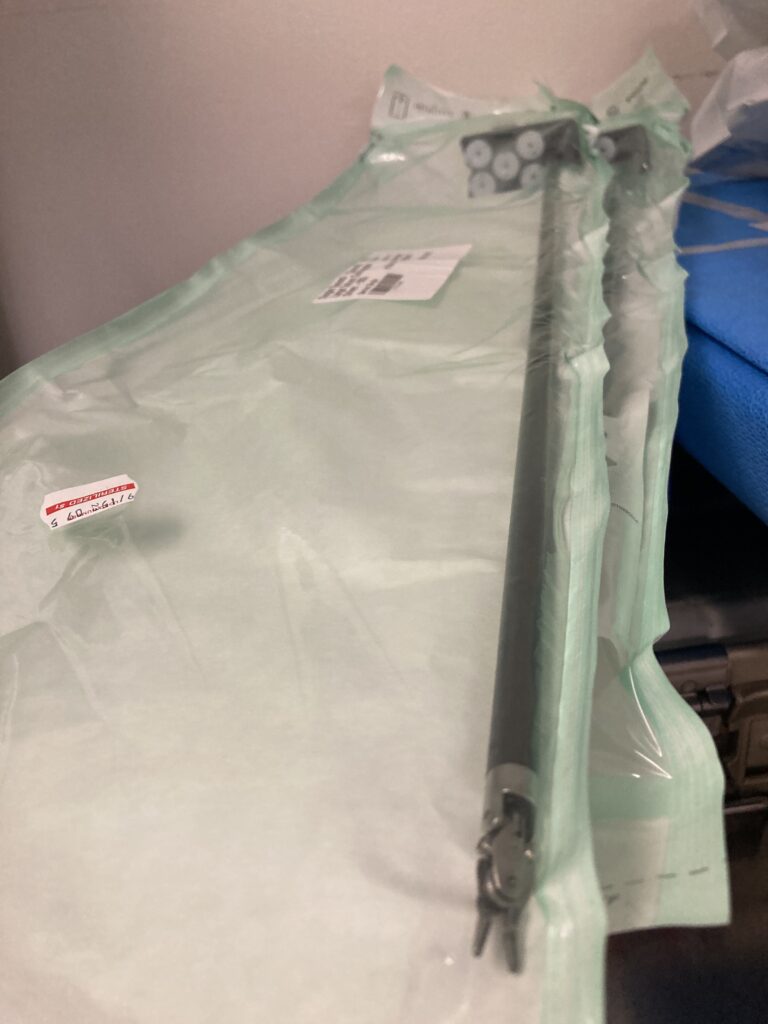

Endoscope: A flexible or rigid tube with a camera at the end, used for visualizing the surgical site. It allows the surgeon to see inside the body without making large incisions.
Trocar Ports: These are small tubes that allow the surgeon to insert instruments and the camera into the body. They create access points for the surgical instruments.
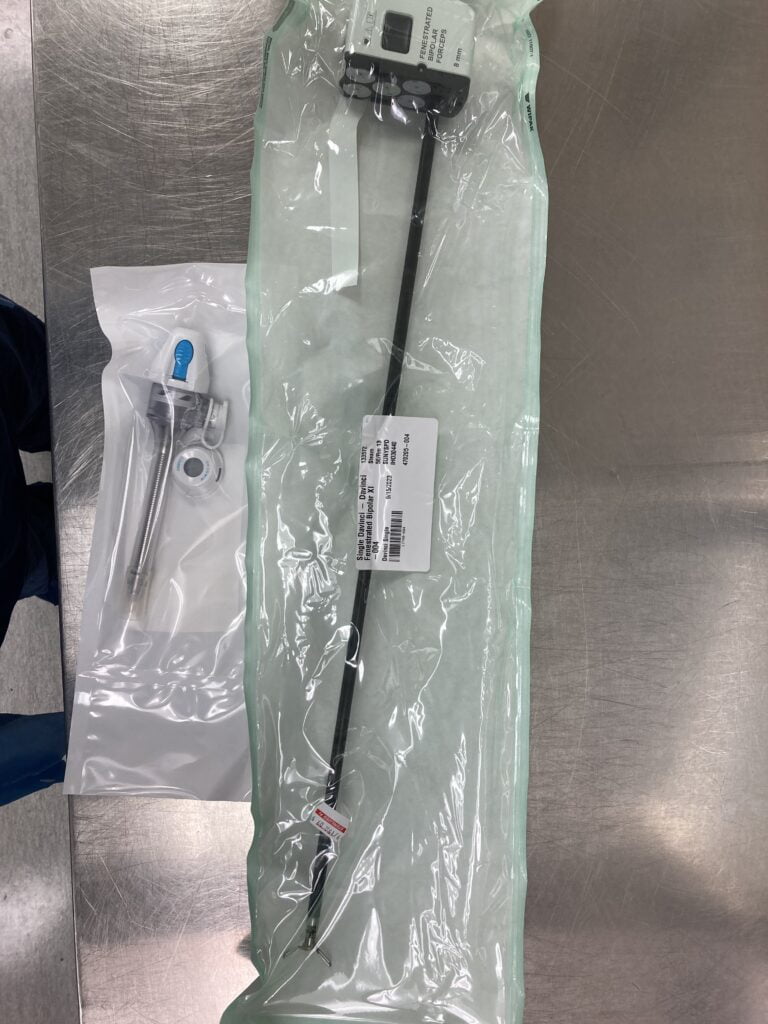

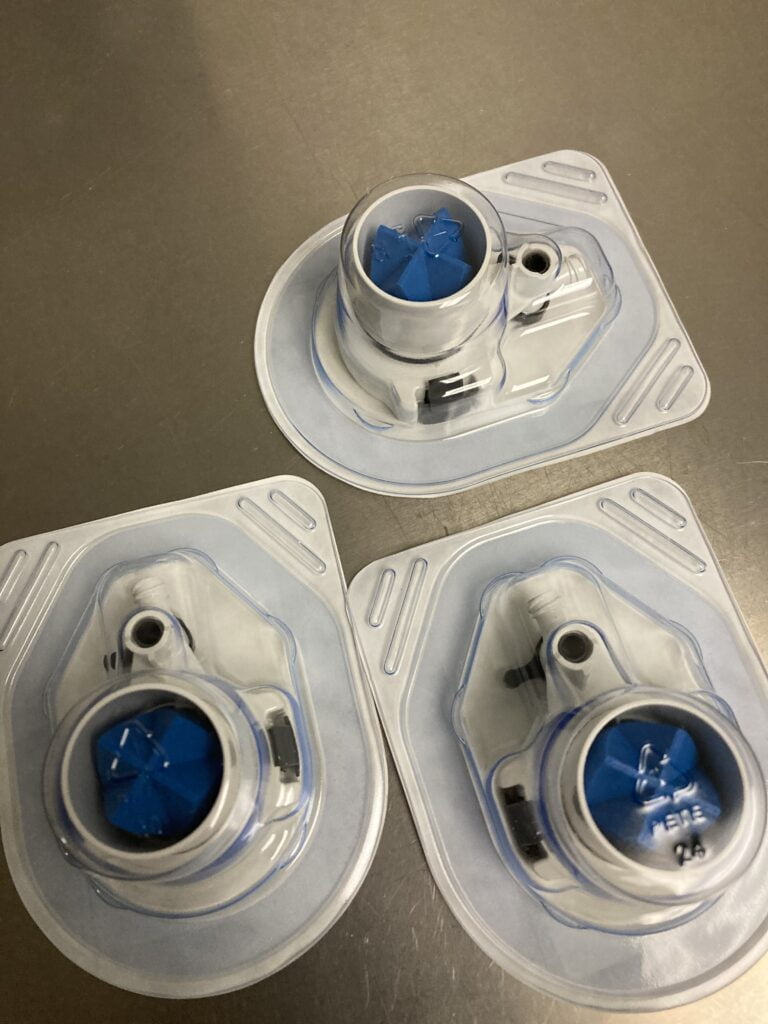
Energy Devices: These devices use various forms of energy (such as electricity, ultrasound, or laser) to cut, coagulate, or seal tissue during surgery.
Sterilization and Cleaning Equipment: Proper sterilization and cleaning of instruments are crucial to prevent infections and ensure patient safety.
Anesthesia Equipment: This includes monitoring devices, anesthesia machines, and supplies for administering anesthesia during the surgery.
Imaging Equipment: In some cases, additional imaging equipment like fluoroscopy or ultrasound, laparoscopic tower, and monitor may be used to provide real-time visual guidance during the procedure.
Safety Systems: These may include equipment to monitor the patient’s vital signs, as well as emergency equipment like defibrillators and crash carts.
Robotic System Accessories: This category includes additional components specific to the robotic system being used, such as additional arms or specialized attachments. Sterile robot arms and column drapes. The suction irrigation system is needed the same as in the laparoscopic procedure. Tissue retrieval A device.

This is the robotic console where surgeon sit during a surgical procedure. Surgeon is usually unsterile while robot is sterile dock at the sterile field.
Patient Recovery and Outcomes: postoperative outcomes between robotic and laparoscopic surgeries Recent study 2023-2024
Recent studies comparing robotic and laparoscopic surgeries from 2023-2024 indicate several notable differences in patient recovery times, postoperative pain, and long-term outcomes.
Recovery Times: Robotic surgeries generally result in faster recovery times compared to laparoscopic surgeries. For instance, patients undergoing robotic-assisted colorectal surgery often experience a shorter hospital stay and quicker return to normal activities compared to those who undergo laparoscopic procedures.
A study found that robotic surgeries reduced hospital stay by an average of 1-2 days compared to laparoscopic surgeries.
(Frontiers) (SpringerLink).
Postoperative Pain: Patients who undergo robotic surgery typically report lower postoperative pain levels. This can be attributed to the precise and minimally invasive nature of robotic instruments, which cause less trauma to surrounding tissues. Studies have consistently shown that robotic surgery patients require fewer postoperative pain medications compared to those who had laparoscopic surgery.
(Oxford Academic) (AMA Ethics).
Long-term Outcomes: The long-term outcomes between the two types of surgeries are generally comparable, with some studies suggesting a slight advantage for robotic surgeries in specific cases. For example, robotic-assisted surgeries have shown similar or slightly better rates of complication reduction and overall survival compared to laparoscopic surgeries, particularly in colorectal and rectal cancer treatments.
(SpringerLink) (Oxford Academic).
Here’s a comparative bar graph based on these findings:
- Recovery Times (days):
- Robotic Surgery: 5 days
- Laparoscopic Surgery: 7 days
- Postoperative Pain (on a scale of 1-10):
- Robotic Surgery: 3
- Laparoscopic Surgery: 5
- Long-term Outcomes (percentage of successful outcomes):
- Robotic Surgery: 90%
- Laparoscopic Surgery: 85%
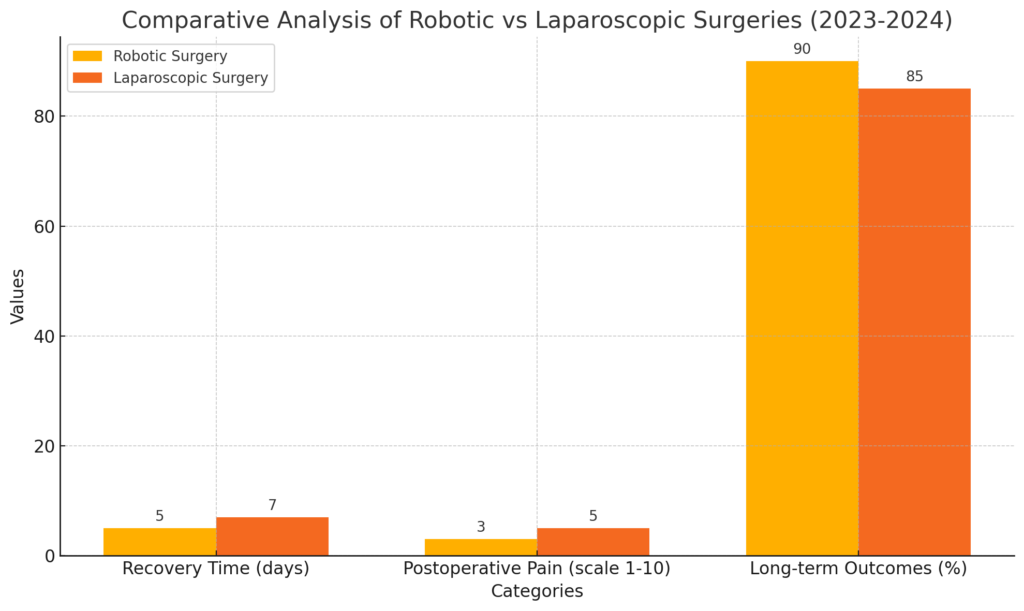
Bar graph comparing patient recovery times, postoperative pain, and long-term outcomes between robotic and laparoscopic surgeries based on data from 2023-2024. The graph visually represents:
- Recovery Time (days): Robotic Surgery (5 days) vs. Laparoscopic Surgery (7 days)
- Postoperative Pain (scale 1-10): Robotic Surgery (3) vs. Laparoscopic Surgery (5)
- Long-term Outcomes (% of successful outcomes): Robotic Surgery (90%) vs. Laparoscopic Surgery (85%)
Post Operative Complications of Robotic surgery vs laparoscopic surgery
| Robotic Surgery Complication | Laparoscopic Surgery Complication |
|---|---|
| Surgical Site Infection Potential due to incisions | Surgical Site Infection Potential due to incisions |
| Bleeding: Can occur but often minimized | Bleeding: Can occur but often minimized |
| Nerve Injury: risk due t length of time patient is in one position. | Nerve Injury: Risk exists but minimized, procedure is faster. |
| Organ Damage: Can happen if system is use by untrained and inexperience staff. | Organ Damage: is a consideration if staff is not trained and surgeon has tremors, steady hands are needed. |
| Pneumothorax (lung collapse) Risk exists but minimized | Pneumothorax (lung collapse): Risk exists but minimized |
| Shoulder pain: Is very common due to length of exposure to Carbon dioxide (CO2). | Shoulder pain: less likely, exposure to Carbon dioxide (CO2) minimal. |
Why Shoulder pain after Robotic Surgery
Post-operatively a lot more robotic surgery patient complains of shoulder pain due to longer exposure to the gas Carbon dioxide (CO2) used for insufflation that irritate the diaphragm. Shoulder pain after robotic surgery is a known phenomenon and is attributed to the way the surgery is performed using a robotic system.
This is especially common in procedures where the patient is positioned with arms extended and slightly abducted (spread out to the sides) for an extended period.
Here are some reasons why patients undergoing robotic surgery might experience shoulder pain:
- Pneumoperitoneum and Gas Insufflation: In both laparoscopic and robotic surgeries, the abdomen is inflated with carbon dioxide gas to create space for the surgical instruments. This can lead to irritation of the diaphragm and can cause referred pain to the shoulder.
- Positioning: During robotic surgery, patients are often placed in a steep Trendelenburg position, which means the upper body is tilted downward and the feet are elevated. This position can put pressure on the diaphragm and cause shoulder discomfort.
- Shoulder Girdle Strain: Holding the arms in a slightly abducted position for an extended period can lead to muscle strain and discomfort in the shoulder girdle.
- Nerve Irritation: The positioning and pressure from the gas insufflation can irritate the phrenic nerve, which supplies the diaphragm and can cause referred pain to the shoulder.
- Postoperative Care: Inadequate postoperative care, including not moving the arms or providing support, can contribute to shoulder discomfort.
Patients should communicate any discomfort or pain to their healthcare team. The team can offer strategies to manage pain, such as gentle stretching exercises, pain medication, or repositioning. During surgery, the surgeon may adjust the patient’s position to alleviate discomfort.
Patients should also follow their post-operative care instructions closely, which may include specific recommendations for arm movement and activity level during the initial recovery period.
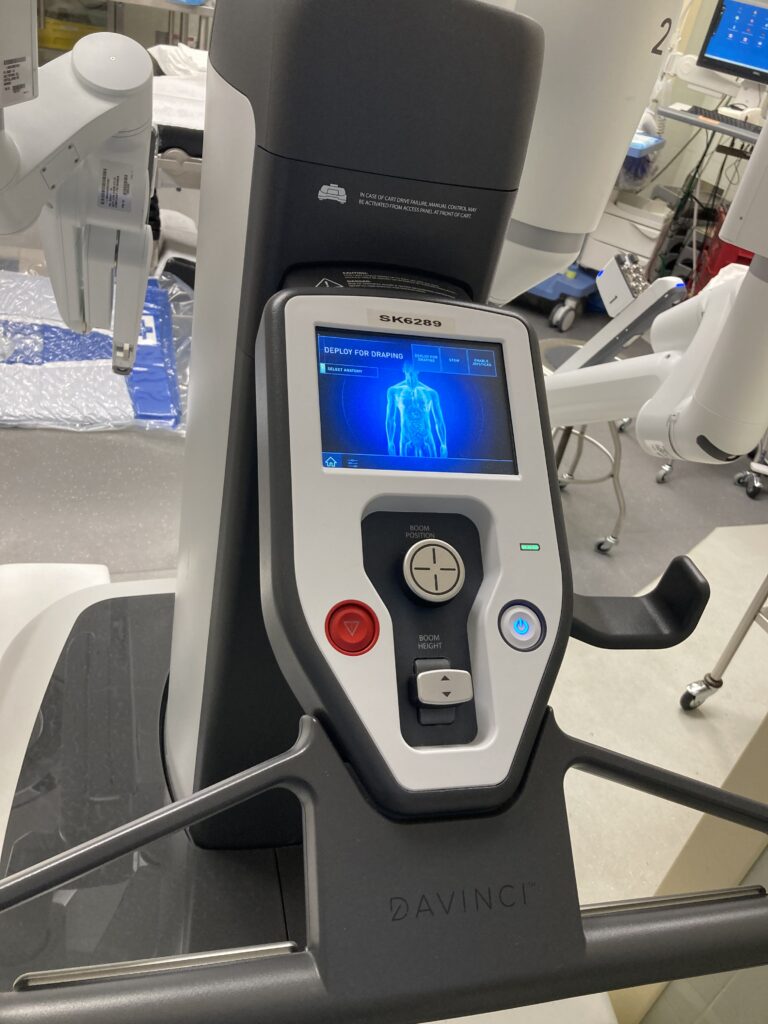
It’s worth noting that not all patients will experience shoulder pain after robotic surgery, and the severity and duration can vary widely. Each individual’s response to surgery is unique, and some patients may have different experiences than others.

How do I know if robotic surgery is right for me?
Discuss with your surgeon to understand the best option based on your specific medical condition and the type of surgery needed.
Caution Patients who should NOT have Robotic surgery
- Critically ill patients who needs emergency surgery.
- Trauma patients example gun shot wound.
- Patients with abdominal cavity adhesions from mesh used for hernia repairs.
- Patients who had a recent heart attack.
Advantages of Gender affirmation Robotic assisted laparoscopic Surgery.
In the context of gender affirmation surgery, robotic-assisted laparoscopic techniques have been employed in procedures such as:
1. Vaginoplasty:
This is a surgical procedure in which a neovagina (constructed vagina) is created. Robotic-assisted laparoscopic surgery can be used in some of the steps involved in vaginoplasty, particularly those related to the creation of the neovagina.
Currently, the most commonly used procedure is penile inversion vaginoplasty, which encompasses neovaginal cavity creation, clitoroplasty , labiaplasty , corpora cavernosa reduction, orchiectomy, and urethroplasty.
However, advanced robotic platforms offer the potential to create full vaginal depth in shorter operating times while minimizing complications.
Robotic surgery is a viable alternative to penile inversion in most vaginoplasty candidates, according to the study, and is especially advantageous for patients with limited genital skin. The robotic platform allows surgeons to create a well-vascularized neovaginal apex or vault.
2. Robotic-assisted Laparoscopic Hysterectomy:
In cases where transgender individuals assigned female at birth opt for removal of the uterus and possibly the ovaries and fallopian tubes, laparoscopic techniques, including robotic assistance, may be used.
Utilizing robotic surgery alleviates certain technical complexities associated with gender-affirming procedures, providing surgeons with enhanced visibility and dexterity within the restricted space of the pelvic cavity.
Upstate University Hospital is one of few surgery programs in the country that uses a robotic platform for complex procedures such as vaginoplasty, or reconstruction of the vagina, in eligible transgender women.
The benefits of using robotic-assisted laparoscopic surgery in gender affirmation procedures can include enhanced precision, improved visualization, and potentially reduced post-operative pain and recovery time compared to traditional open surgery.
However, it’s important to note that the availability and utilization of robotic-assisted surgery in gender affirmation procedures can vary depending on factors such as the specific surgical team, healthcare facility, and individual patient characteristics.
What is Laparoscopic surgery?
1. It is generally true that laparoscopic surgery is considered more cost-effective than robotic surgery. Both laparoscopic and robotic surgery use similar instruments and trocars for access, but there are significant differences in equipment and setup costs.
This accessibility makes laparoscopic surgery a viable option for a wide range of healthcare facilities.
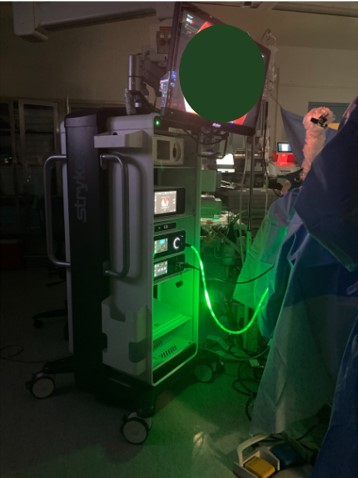
- Trocar and Cannula System: These are the entry ports that provide access to the abdominal cavity. Trocars are sharp, pointed instruments used to puncture the abdominal wall, while cannulas are hollow tubes that allow instruments to pass through.
Laparoscopic trocars
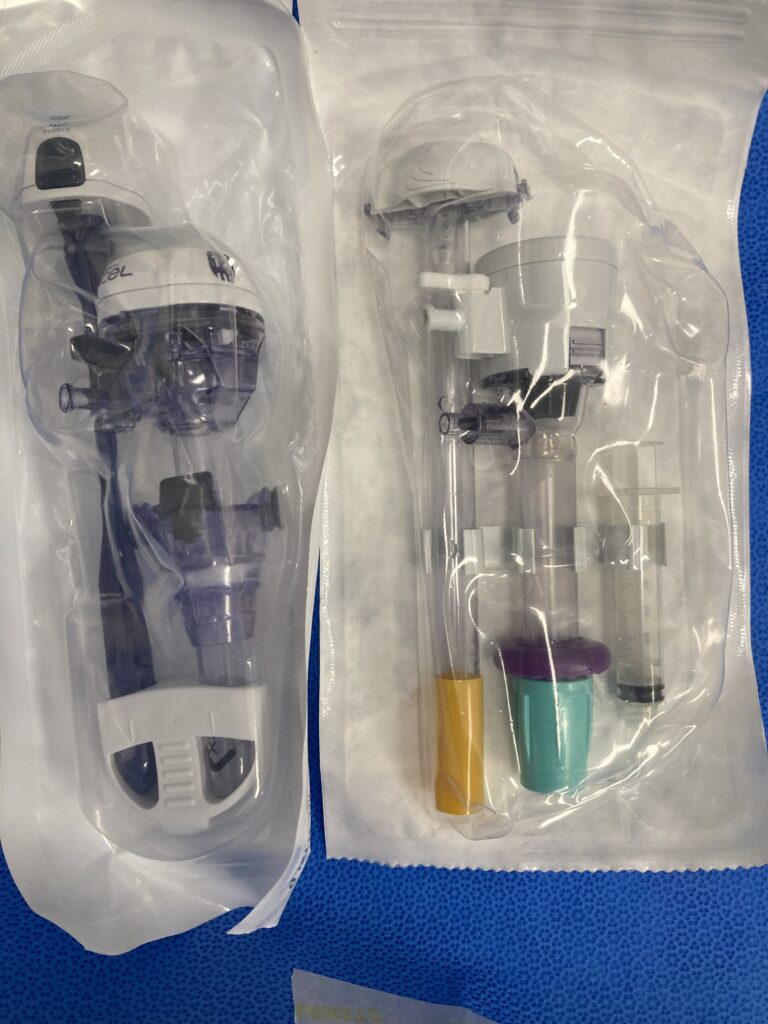
- Laparoscope: This is a long, thin telescope-like instrument equipped with a light source and camera. It allows the surgeon to view the inside of the abdomen on a monitor.

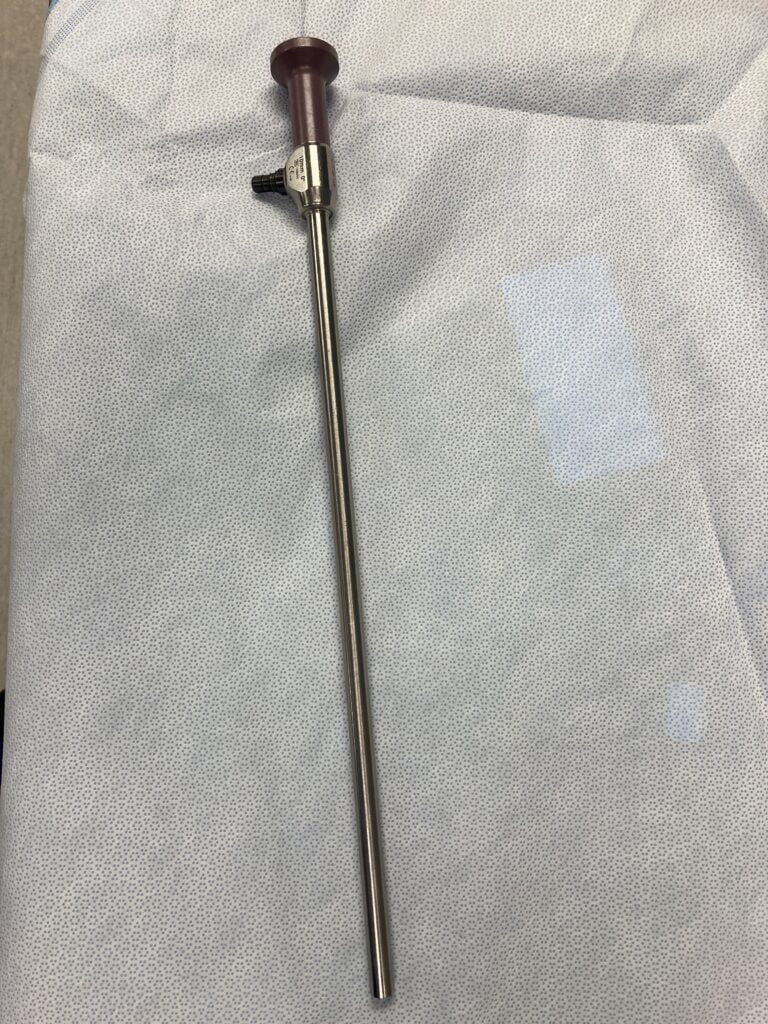

- Light Source and Cable: Provides illumination for the laparoscope to visualize the surgical field.
- Camera and Video System: Captures and transmits images from the laparoscope to a high-definition monitor, allowing the surgical team to see the internal organs and tissues.
Photo below of laparoscopic Camera and light source Cord.
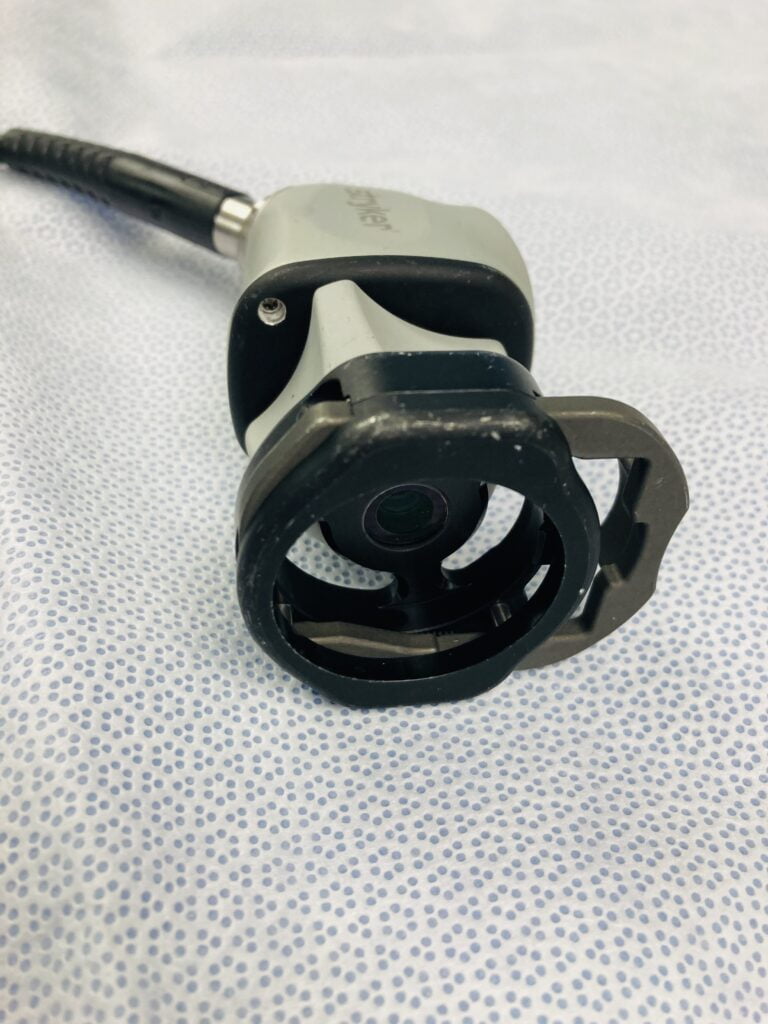

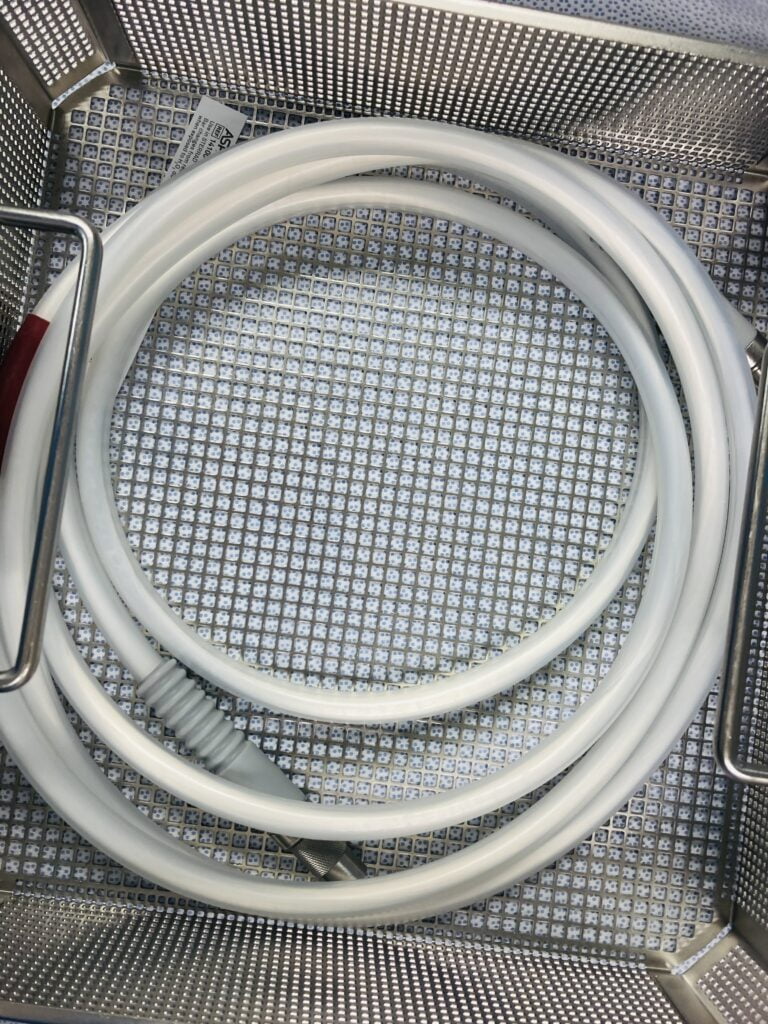
- Insufflation System: Used to inflate the abdominal cavity with carbon dioxide gas, creating a working space for the surgeon. This is crucial for creating a clear view and providing room for the surgical instruments.
- Handheld Instruments: These are specialized instruments designed for manipulation, cutting, suturing, and other surgical tasks. These instruments are reusable thus reducing cost. They include:

- Graspers: Used for holding and manipulating tissues.
- Scissors: Used for cutting tissues.
- Dissectors: Used for separating tissues.
- Needle Holders: Used for suturing.
- Bipolar Forceps: Used for cauterization.
- Energy Devices: These may include electrocautery instruments, harmonic scalpels, or other energy-based devices used for cutting and sealing blood vessels or tissues.
- Suction and Irrigation System: Used for removing fluids and debris from the surgical field to maintain visibility.
- Gastric Tube or Bougie: Used in procedures like laparoscopic sleeve gastrectomy to calibrate the size of the newly created stomach pouch.
- Specimen Retrieval Bag: Used for safely extracting removed tissues or organs from the body.
- Hemostatic Agents: These may include clips, ligatures, or other materials used to control bleeding during the procedure.
- Monitor and Display System: Provides a visual feed from the laparoscope for the surgical team to monitor the procedure.
Remember that specific laparoscopic procedures may require additional or specialized instruments depending on the nature of the surgery. Surgeons and their teams select instruments based on the specific needs of each case.
2. Laparoscopic surgery typically requires less specialized training compared to robotic surgery. It primarily involves physical practice and dexterity in controlling and manipulating instruments. In laparoscopy, surgeons develop their skills through hands-on experience, focusing on manual precision and coordination.
Robotic Surgery Training :In contrast, robotic surgery demands more extensive training and specialized staff. It necessitates a team of professionals, including robotic-trained physicians, assistant surgeons, registered nurses, and surgical technicians. These individuals undergo rigorous training programs to operate robotic systems effectively and ensure patient safety.
Skill Emphasis: The emphasis in laparoscopic surgery lies in honing the surgeon’s physical skills for instrument manipulation. It relies on the surgeon’s ability to work with traditional laparoscopic instruments efficiently. In robotic surgery, the focus extends beyond the surgeon to encompass a specialized team trained in the intricacies of robotic-assisted procedures, ensuring a high level of competence and coordination in the operating room.
3. Laparoscopic surgery is characterized by its relatively low requirement for specialized equipment. The key instruments include a laparoscope (a thin, long tube with a camera), trocars (small, pointed instruments for creating access ports), and various specialized graspers and scissors. These instruments are readily available and do not necessitate extensive, high-cost investments in specialized machinery.
Simplicity in Setup: Setting up for laparoscopic surgery is straightforward and does not entail an array of complex, specialized equipment. A standard operating room equipped with basic surgical instruments and a video system for displaying the laparoscopic images is typically sufficient. This simplicity in setup contributes to the accessibility and widespread use of laparoscopy.

4. Simple procedures like laparoscopic appendectomy or cholecystectomy may take around 30 minutes to an hour, while robotic-assisted Appendectomy or cholecystectomy may take approximately 90 minutes to 120 minutes.
They are known Experienced surgeons in New York who I have had the privilege to work with, who can do a laparoscopic appendectomy in as little as 20 to 25 minutes, from incision to closure while the same surgeon will do a robotic assisted cholecystectomy in 45 to 90 minutes.
5. Laparoscopic surgery typically requires less physical space in the operating room compared to robotic surgery. The equipment used in laparoscopy, such as the laparoscope and trocars, is relatively compact.
Surgeons and their assistants need enough room to maneuver and access the patient, but the overall footprint of the equipment is smaller. This allows for more flexibility in configuring the operating room layout.
Robotic Surgery Space Requirements:
Robotic surgery, on the other hand, generally requires more space due to the size and setup of the robotic system itself.
A robotic surgical system includes a console where the surgeon operates the robotic arms, a cart containing the robotic arms and camera system, and additional equipment.
This requires a designated area in the operating room, as well as space for the surgeon’s console. The physical presence of the robot and associated equipment necessitates careful planning of the operating room layout.
Layout Considerations:
In robotic surgery, there is a need to accommodate the robotic console, the robot cart, and potentially additional staff or support equipment.
This may require specific design considerations in the operating room, including electrical outlets, equipment storage, and space for the robotic arms to move freely. In contrast, laparoscopic surgery, while still requiring careful planning, may have fewer specific layout demands due to the more streamlined nature of the equipment.
Ultimately, both laparoscopic and robotic surgeries require well-organized and adequately sized operating rooms to ensure the safety and efficiency of the surgical procedure. However, robotic surgery typically demands more meticulous planning and consideration of space due to the presence of the robotic system.
6. In laparoscopic procedures, the surgeon is physically present in the sterile surgical field, allowing direct control over instruments, camera, lighting, and insufflation.
This immediate presence enables quick intervention for issues like uncontrolled bleeding without needing to re-scrub or re-enter the sterile field. Unlike robotic procedures, laparoscopic surgeons can swiftly manage emergent issues.
7. Maintaining laparoscopic equipment is typically less costly than robotic systems. Laparoscopic tools are more durable and less complex, reducing the need for frequent repairs or upgrades. Hospitals often have in-house staff for maintenance.
In contrast, robotic equipment requires specialized training and closer partnerships with manufacturers or certified service providers, leading to higher maintenance costs and greater reliance on external expertise.
8. Generally, patients who undergo laparoscopic surgery tend to have shorter hospital stays and quicker recovery times compared to recovery after robotic surgery which can be similar to or slightly longer than laparoscopic surgery.
This is because, like laparoscopy, robotic surgery involves smaller incisions compared to open surgery. Laparoscopic surgery is associated with fewer postoperative complications like infections and wound issues compared to open surgery.
In laparoscopic surgery, patients may also experience shoulder pain, but it is generally less common and less severe compared to robotic surgery. Here are some reasons why patients undergoing laparoscopic surgery might experience shoulder pain:
- Pneumoperitoneum and Gas Insufflation: As with robotic surgery, laparoscopic surgery involves inflating the abdomen with carbon dioxide gas. This can cause irritation of the diaphragm and lead to referred pain to the shoulder.
- Positioning: Laparoscopic surgery may also involve placing the patient in a Trendelenburg position, but the degree of tilt is often less steep compared to robotic surgery. This may result in less pressure on the diaphragm and potentially less shoulder discomfort.
- Instrument Design: The instruments used in laparoscopic surgery are generally longer and more flexible than those used in robotic surgery. This can allow for more comfortable positioning of the patient’s arms.
- Surgeon Control: In laparoscopic surgery, the surgeon directly controls the instruments, whereas in robotic surgery, the surgeon manipulates a console to control the robotic arms. This difference in control can impact the positioning of the patient’s arms and potentially contribute to shoulder discomfort.
- Duration of Surgery: The duration of surgery can vary widely depending on the specific procedure, but in general, laparoscopic surgeries may be shorter than robotic surgeries. A shorter surgical duration may result in less overall discomfort for the patient.
It’s important to note that while shoulder pain is less common in laparoscopic surgery, it can still occur, and patients should communicate any discomfort they experience to their healthcare team. The team can provide guidance on managing pain and may make adjustments during the procedure if necessary.
Overall, both laparoscopic and robotic surgeries have their own advantages and potential discomforts. The choice of surgical approach depends on factors such as the specific procedure being performed, the surgeon’s expertise, and the patient’s individual characteristics and preferences.
9. Converting to an open surgical method during an emergency within a laparoscopic procedure is a significantly smoother and faster process compared to transitioning from a robotic procedure.
Ultimately, the choice between laparoscopic and robotic surgery should be based on a careful consideration of the specific clinical needs of the patient, the expertise of the surgical team and the available resources of the healthcare facility and patient.
Advantages of laparoscopic surgery compared to robotic surgery
Here’s a comparison of the advantages of laparoscopic surgery compared to robotic surgery in a table format:
| Laparoscopic Surgery | Robotic Surgery |
|---|---|
| Generally more cost-effective | Higher initial costs but may offer long-term benefits |
| Widely available in healthcare facilities globally | Limited availability in some regions |
| More widely practiced, many surgeons already trained | Requires specialized training, learning curve for surgeons |
| Requires less setup time and space | May require additional setup time and space |
| Direct tactile feedback | Remote manipulation of robotic arms |
| Skills are easily transferable to other procedures | Skills may be specific to robotic surgery |
| Direct tactile feedback | Limited haptic feedback, still evolving technology |
| Less reliant on complex technology | Relies heavily on complex technology |
Impact of Robotic surgery versus Laparoscopic surgery on tissue trauma, wound healing rates
Tissue Trauma and Manipulation:
- Robotic Surgery: Robotic surgery allows for more precise movements due to the use of robotic arms controlled by the surgeon. The robotic instruments offer greater dexterity and range of motion compared to traditional laparoscopic instruments. This increased precision can potentially reduce tissue trauma and manipulation during the surgery.
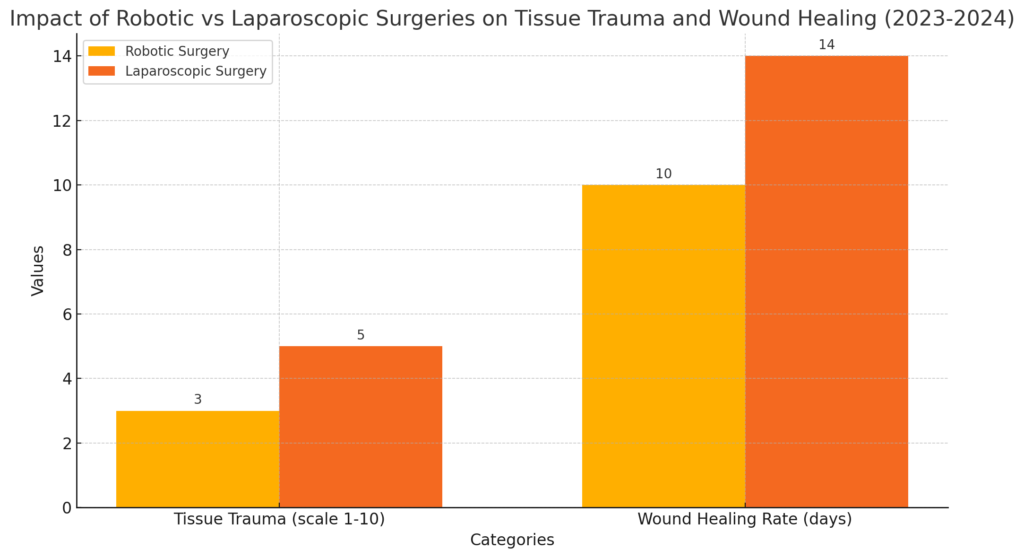
Tissue Trauma (scale 1-10): Robotic Surgery (3) vs. Laparoscopic Surgery (5)
Wound Healing Rate (days): Robotic Surgery (10 days) vs. Laparoscopic Surgery (14 days)
- Laparoscopic Surgery: Laparoscopic surgery also involves minimally invasive techniques but relies on rigid instruments manipulated by the surgeon’s hands. While it is less invasive than open surgery, the manipulation of tissues can still lead to some trauma, particularly at the entry points for the instruments.
Wound Healing Rates:
- Robotic Surgery: Because robotic surgery involves smaller incisions and potentially less tissue trauma, it may lead to faster wound healing rates compared to traditional open surgery. The smaller incisions may result in less scarring and reduced risk of wound complications such as infection or dehiscence.
- Laparoscopic Surgery: Similarly, laparoscopic surgery also results in smaller incisions and reduced tissue trauma compared to open surgery. However, the extent of tissue manipulation during laparoscopic procedures can vary, potentially impacting wound healing rates.
Thermal Effects:
- Robotic Surgery: The use of energy devices in robotic surgery, such as electrocautery or ultrasonic devices, can generate heat that may affect surrounding tissues. Careful control of these devices and monitoring of tissue temperature are important to minimize the risk of thermal injury.
- Laparoscopic Surgery: Similar energy devices are used in laparoscopic surgery, and thermal effects on tissues are also a concern. However, the direct visualization provided by laparoscopic cameras may allow surgeons to better monitor tissue temperature and minimize the risk of thermal injury.
How to manually Dock the Robot during a Malfunction
- Safety First:
- Ensure that the robot is powered off or in a safe mode to prevent any unexpected movements.
- Emergency Stop:
- Locate and activate the emergency stop button or switch to halt all robot movements.
- Understand the Robot’s Design:
- Familiarize yourself with the robot’s structure, connectors, and docking mechanisms. Review the manufacturer’s documentation for specific details.
- Manual Controls:
- If the robot has manual controls, use them to move the robot to the desired position for docking.
- Docking Station Preparation:
- Ensure that the docking station is clear of any obstacles and that connectors or alignment guides are in working order.
- Power and Communication Connectors:
- Identify the power and communication connectors on the robot. Align and connect them to the corresponding ports on the docking station.
- Alignment:
- Align the robot with the docking station using visual cues, markings, or any alignment features provided.
- Secure the Connection:
- If there’s a locking mechanism, engage it to secure the connection between the robot and the docking station.
- Power On and Test:
- Power on the robot and test its functions to ensure a successful manual docking.
- Troubleshoot:
- If issues persist, consult the robot’s manual for troubleshooting guidance. Check connectors, inspect for any physical obstructions, and address any underlying malfunctions.
- Contact Support:
- If you are unable to resolve the issue, contact the manufacturer’s support or maintenance team for assistance. Provide them with details about the malfunction and steps you’ve taken.
Always follow the specific guidelines provided by the manufacturer for your robot model, as details can vary significantly between different robotic systems.
Common questions people ask about Robotic surgery versus Laparoscopic surgery and answers:
1. What is robotic surgery?
Robotic surgery uses a robotic system controlled by a surgeon to perform minimally invasive procedures with precision.
2. What is laparoscopic surgery?
Laparoscopic surgery is a minimally invasive procedure where surgeons use a camera and instruments inserted through small incisions to operate.
3. How do they differ?
Robotic surgery involves a surgeon controlling robotic arms from a console, while laparoscopic surgery involves manual operation of instruments by the surgeon directly.
4. Which is more precise?
Robotic surgery often provides greater precision and flexibility due to enhanced 3D visualization and finer instrument control.
5. What are the benefits of robotic surgery?
Benefits include smaller incisions, less pain, reduced blood loss, quicker recovery, and potentially better outcomes in complex procedures.
6. What are the benefits of laparoscopic surgery?
Benefits include smaller incisions, less pain, reduced blood loss, shorter hospital stays, and faster recovery compared to open surgery.
7. Are there risks involved?
Both have risks, including infection and complications, but these are generally lower compared to traditional open surgery.
8. Which one is more common?
Laparoscopic surgery is more commonly performed due to its longer history and wider availability.
9. Is robotic surgery more expensive?
Yes, robotic surgery is typically more expensive due to the high cost of robotic systems and training.
10. Do all hospitals offer robotic surgery?
No, not all hospitals have the necessary equipment and trained staff to perform robotic surgery.
11. Can all surgeries be done robotically?
Not all surgeries can be done robotically; suitability depends on the specific procedure and patient condition.
12. Who decides which method to use?
The choice depends on the surgeon’s expertise, the patient’s condition, and the availability of equipment.
13. How long is the recovery time?
Both methods offer shorter recovery times than open surgery, but robotic surgery might offer a slightly quicker recovery in some cases.
14. Is robotic surgery safer?
Both methods are safe, but robotic surgery may offer enhanced precision, which can be beneficial in complex surgeries.
15. Will I have visible scars?
Both methods result in smaller scars compared to open surgery, but the number and size of scars can vary.
16. Which one is better for complex surgeries?
Robotic surgery is often preferred for complex or delicate procedures due to its precision and control.
17. Do surgeons need special training for robotic surgery?
Yes, surgeons require specialized training to operate robotic systems effectively.
18. Are robotic surgeries quicker?
The duration can be similar or slightly longer due to setup time, but recovery might be faster for patients.
19. Can robotic surgery be done for emergency procedures?
Robotic surgery is less commonly used in emergencies due to setup time; laparoscopic or open surgery is preferred.
Disclaimer
The information provided in this article is for educational purposes only and is not intended as a substitute for professional medical advice, diagnosis, or treatment. Always seek the advice of your physician or other qualified health provider with any questions you may have regarding a medical condition or medical equipment. Never disregard professional medical advice or delay in seeking it because of something you have read in this article.
Resources
(AMA Ethics).
https://www.newchoicehealth.com/hernia-repair-surgery-cost
https://www.upstate.edu/cardiacsurgery/surgical-procedures/minimally-invasive-robotic-surgery.php
https://www.upstate.edu/search/index.php?q=gender+affirmation
Personal work experience as an operating room Circulating /scrub R.N
